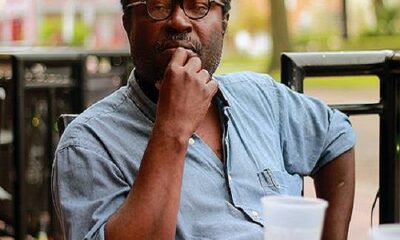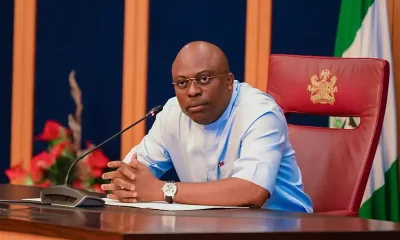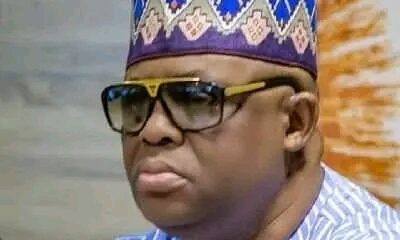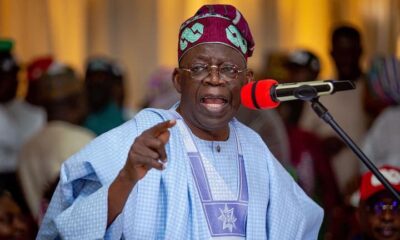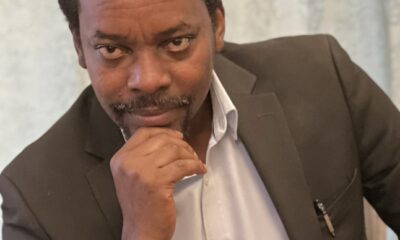National Issues
Off-Loading the Presidential Fleet -By Eric Teniola
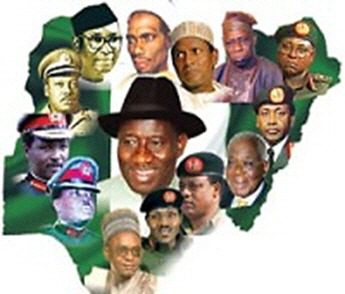
Until 1999, the Presidential Fleet was under the control and supervision of the Secretary to the Government of the Federation.
Before 1999, senior air force officers in their grey upon blue well ironed uniforms were seen on the eleventh floor of the Federal Secretariat which was then the office of the Secretary to the Government of the Federation, hanging around.
But in June 1999, President Olusegun Obasanjo transferred the fleet to be part of the schedule of the Chief of Staff to the President.
The argument was that since the Chief of Staff was the head of the staff attached to the President and since he was aware of the hourly movement of the President, he was in a better position to control the fleet adequately. I understand that the fleet is now under my friend, Col. Sambo Dasuki (rtd.) the National Security Adviser whose loyalty and patriotism are never in doubt. Before 1999, the fleet was almost dormant for lack of use.
General Ibrahim Babangida hardly travelled outside the country, except on a few visits some states, and Chief Earnest Oladeinde Adegunle Shonekan, whose tenure lasted less than 100 days made use of the fleet only once when he attended the Commonwealth Conference outside Nigeria. The second time he used the fleet was when he was overthrown and brought down to Lagos in company of Chief Dapo Sarumi.
General Sani Abacha hardly travelled outside Abuja; in fact during his era, pilots attached to the Presidential Fleet complained of underutilisation, raising fears that they might lose their licenses for not flying enough. In 1997, he made only five trips outside Abuja; in 1998, he made three trips, the fourth would have taken him to Ouagadougou in Burkina Faso on June 8, 1998 for the African Union Conference, the very day that he died.
General Abdusalam Abubakar who spent less than eleven months in office was too busy with his transition programme that he hardly travelled. He made four trips during his era, two to the Niger Delta to inspect the oil spillage in that area.
As for President Olusegun Okikiolu Obasanjo, the Jagunmolu of Egbaland, he was a flying President. Even till today that the Presidential Fleet is outside his control, he is still flying around the world. He loves to fly. That is the way he is. And the Pilots attached to the Presidential Fleet loved him for that.
The Presidential Fleet still remains the most important posting in the Nigerian Air force. For example, the present Chief of Defence Staff, Marshall Alex Sabundu Badeh was a product of the Presidential Fleet, as he flew former Vice-President Atiku Abubakar between 1999 and 2007 severally.
Even the present Chief of Air Staff, Air Marshal Adesola Nunayun Amosu was a product of the Nigeria Presidential Air Fleet too. The Fleet has one of the largest Aircrafts in the world in comparison to other countries.
The British Prime Minister has no Presidential Aircraft. Members of the British Government charter either British Airways or Virgin Atlantic most times. The government of Tunisia operates a Boeing 737 BBJ. An Airbus A340-500 has also been purchased with VIP configuration, but was never used for travel and has been stored since the 2011 revolution that ousted former dictator Ben Ali. The Tunisian government is reportedly trying to sell off both aircrafts.
The government of Algeria operates an Airbus A340-500. The Chief Executive of Hong Kong travels on commercial aircrafts, usually operated by Cathay Pacific. He travels within the country in helicopters operated by the Government Flying Service. The Ivorian government uses a Gulf IV as a VIP aircraft. Further they also use a government Boeing 727-200WGL.
The State of Israel does not currently possess a specific jet for use of its Head of State. Whenever the current Prime Minister Benjamin Netanyahu flies long distances (out of the country), the government leases an airliner from the state airline El Al. Meanwhile, the President Reuvin Rivlin and other high ranking dignitaries are relegated to El Al first class commercial service. As of 2014, the Knesset was considering the purchase of such an airplane, dubbed “Israeli Air Force One.”
Kenya’s President has a Fokker-70 for use as the presidential jet. The Fokker executive plane was purchased at a cost of $50 million. The 70-seater jet was reconfigured with telecommunication facilities. Prior to the purchase of the Fokker, the Kenya President primarily used Kenyan Airways for his international travel.
The Saudi Arabian Royal Flight operates a Boeing 747-300 and a Boeing 747-400 for use of the King. The President, Prime Minister of Singapore and government officials typically travel on regular scheduled commercial flights run by Singapore Airlines. However, on rare occasions or short trips, government officials may travel on one of the few passenger-configured Fokker-50 operated by the Republic of Singapore Air Force.
The President of South Africa travels in a Boeing 737 (BBJ) operated by the South African Air Force’s 21 Squadron, which is based at AFB Waterkloof near Pretoria, the executive capital. 21 Squadron also operates a fleet of two Falcon 50 and a Falcon 900B Fleet, 550/1 Citation 2, and a Global Express XRS is hired to escort the President on long flights as a back-up aircraft. The Falcon 900 is normally used by the Deputy President and high-ranking cabinet ministers.
The President of Zimbabwe travels in a charted Air Zimbabwe Boeing 767-200ER aircraft, which is part of the national airline’s fleet. Occasionally, the President will share the plane with commercial passengers on scheduled flights. The Tanzania Government Flight Agency operates a Gulfstream G550 for VIP transports. There are other two other VIP aircraft a Fokker F-50 and F-28 for internal and regional destinations as well.
The President of Ghana flies on a Falcon EX 900 jet. The Botswana Defence Force operated a Gulfstream IV transport that has since been sold and the Botswana Defence Force now operates a Global Express OK1. The government of Burkina uses a special Boeing 727. A Falcon 900 has been added, and is the type frequently in use now. The Egyptian government operates an Airbus A340-200 as a VIP transport. The first presidential airplane was given as a gift from Saudi Arabia to Egypt.
The Pope is one of the richest and famous men on earth. He is the Head of the Catholic Church that has followership all over the world. Typically, the Pope flies on a chartered Alitalia fixed-wing aircraft when travelling to or from more distant destinations. Traditional protocol dictates that a Pope flies to a country he is visiting on a chartered Alitalia jet and returns on a jet belonging to a flag carrier from the visited nation; this may vary when he is touring multiple nations.
The Nigerian’s Presidential Air fleet is being maintained with over 10 billion naira budget annually.
Poor states like Osun, Gombe, Ebonyi, Ekiti gets less than 2 billion naira every month from the Federal Mobilisation Fiscal Commission as allocation. The Presidential Fleet of Nigeria has the third largest Air fleet in the country, coming behind Arik which has twenty-two airplanes and Aero Contractors with fourteen planes. The Presidential Air Fleet has ten Aircrafts. These include, two falcon 7X jets, two Falcon 900 jets, Gulfstream 550, one Boeing 737 BBJ (Nigerian Air Force 001 or Eagle One), and Gulfstream IVSP. Others are one Gulfstream V, Cessna Citation 2 aircraft and Hawk Siddley 125-800 jet.
Each of the two Falcon 7X jets purchased in 2010 cost $51.1m, while the Gulfstream 550 costs $53.3m. Airline CEOs put the average price of Falcon 900 at $35m, Gulfstream IVSP at $40m, Gulfstream V at $45m, Boeing 737 BBJ at $58m, Cessna Citation, $7m and Hawker Siddley 125-800 at $15m.
In addition, the Federal government, last year, submitted several new items to be purchased by the Presidential Air Fleet to the National Assembly for approval. The items listed as new in the PAF budget are – the completion of hanger project (N405,500,000.00), tyre bay tools and equipment (N106,000,000.00), Towberless tow tractor for aircraft towing (N58,740,000.00), hanger sweeper (N31,870,000.00), luggage conveyor belt truck (N28,898,000.00) and Harlan tow aircraft equipment towing (N27,590,000.00).
Other news items are – CCTV and surveillance equipment (N18,000,000.00), aircraft tools and equipment (N11,480,000.00), battery workshop equipment (N5,050,000.00), complete tool box for general works and vehicles (N360,000.00), heavy duty crocodile jacks (N300,000.00), aluminium ladder (N285,000.00), safety boots (N52,500.00) and foldable ladder (N50,000.00).
The question before us is can we maintain the Presidential Air Fleet in the face of our dwindling economy? The answer is no.
The alternative is to sell some of the aircrafts so as to reduce cost. It is even cheaper to charter planes for some of our top officials than to maintain the Presidential Air Fleet as it is now.
The other angle is to let the Nigerian Air force face other challenges, instead of the present rivalry among senior officers over posting to the Presidential Air Fleet.
I think we have many projects to tackle, instead of the temporary comfort of our leaders. All these are for the consideration of the incoming government of Major General (rtd.) Muhammadu Buhari.
In his Essays of Innovation, Francis Bacon wrote “And he that will not apply New Remedies, must expect New evil; for time is the greatest innovator.”
Eric Teniola, a former Director at the Presidency, lives in Lagos


